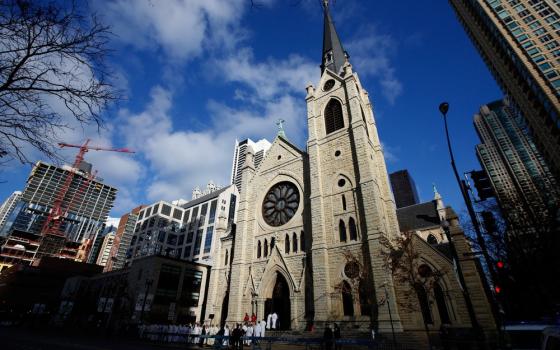
Analysis
The night before the Nov. 7 final vote on health care reform in the House of Representatives, Speaker Nancy Pelosi was shuttling between gatherings of pro-choice legislators and antiabortion forces, the latter including officials of the U.S. Conference of Catholic Bishops.
In the end, according to numerous reports, it was the pro-choice group that spurned all efforts at compromise. Pelosi was forced to abandon her pro-choice allies to allow a vote on the amendment advanced by Congressman Bart Stupak, a moderate Democrat from upstate Michigan. As the health reform effort heads now to the Senate, the Catholic church, both its hierarchy and laity, stands in the center of the debate. On the line is not only the long-elusive goal of universal health coverage but also President Obama’s effort to reach out to moderate Catholic voters.
With the Republican Party all but marginalized in its unyielding opposition to almost any reform effort, the wide variety of opinions within the Democratic Party on different aspects of the legislation became all the more apparent.. The most vexing issue is that of federal funding for abortion.
All summer long, Pelosi and her allies had tried to convince their colleagues that the Capps Amendment, segregating the federal funds from the premiums paid by individuals, had solved the issue. And all summer long, pro-life members had said that the Capps Amendment amounted to an accounting gimmick. Factcheck.org, a nonpartisan group that evaluates the veracity of political claims, agreed that Capps amounted to federal funding of abortion coverage. The issue would not go away.
The night before the vote, Stupak led the pro-life negotiators and had officials from the bishops’ conference with him in his office. At Pelosi’s invitation, they moved to a room in the speaker’s office. In another room in the same suite was a group of pro-choice lobbyists. For two hours, the discussion went back and forth until Pelosi threw her support behind Stupak’s amendment. Late Saturday evening, the House voted to support Stupak and passed the final health care bill.
The amendment did more than bar federal funding for abortion in both the public option and in any plans purchased through the “exchanges,” the markets the legislation sets up if those plans were subsidized by the federal government. The bill requires that any insurance company plan that covers abortion offered in the exchanges, even one being purchased by someone with their own money and no federal subsidy, has to be matched with an identical plan that does not include such coverage.
The Stupak Amendment does not forbid the purchase of plans that cover abortion, but the actuary for the insurance companies said that functionally no companies would offer such plans because the pool of applicants would be too small to make them economically feasible.
The bishops and staff at the bishops’ conference were elated by the victory in the House. Richard Doerflinger, associate director of the conference’s Committee on Pro-Life Activities and one of those who has been most insistent on guaranteeing the bill would not provide federal funding for abortion, said that once the Stupak Amendment passed, “we became enthusiastic advocates for moving forward with health care reform.”
In his weekly blog, Cardinal Sean O’Malley of Boston wrote, “We were very pleased that the [Stupak] Amendment was passed by such a large margin in the House. I think it shows that the representatives are aware that the American people, as a whole, do not want the government to be funding abortions.”
Representatives, of course, do not represent the American people “as a whole.” They represent distinct districts, most of which have been carved with computer precision to ensure that the district is “safe,” filled with a sufficient majority of one party or the other that the incumbent faces no serious challenge. But moderate Catholic swing voters, who have become critical in both presidential elections and in those few swing districts that could conceivably switch in next year’s midterm elections, could prove unpredictable.
They may not be rigidly pro-choice or rigidly pro-life. All the evidence suggests they are ambivalent about abortion, not wanting a return to the days of back-alley abortions, but also not wanting to encourage the procedure with government subsidies.
The language of the Stupak Amendment appears to express their ambivalence. Pelosi, who can only remain speaker if Democrats from conservative swing districts win next year, knows that forcing them to vote for a pro-choice bill would be suicidal for them, and for her position as speaker.
The president has spent a good deal of time, both during and since the election, trying to find common ground on the thorny subject of abortion. He knows that he benefited from a 14-point swing among Catholics between 2004 and 2008, and that part of the reason for that swing was his respect for pro-life Democrats such as Pennsylvania Sen. Bob Casey and willingness to commit to policies that aim to reduce the abortion rate. During a speech to Congress in September, Obama pledged himself to no government funding of abortion. The president is pro-choice, but like Pelosi, he knows that using health care reform to increase abortion coverage is a sure way to see that 14-point swing go back the other way.
In the Senate, conditions may favor the search for common ground on health care legislation. Senators represent whole states, and they can’t be redistricted. Additionally, liberals who want reluctant senators to back the public option might now offer their support for the Stupak approach in exchange for the conservative senators’ vote for the public option.
Michael Sean Winters is an NCR contributor and lives in Silver Spring, Md.




